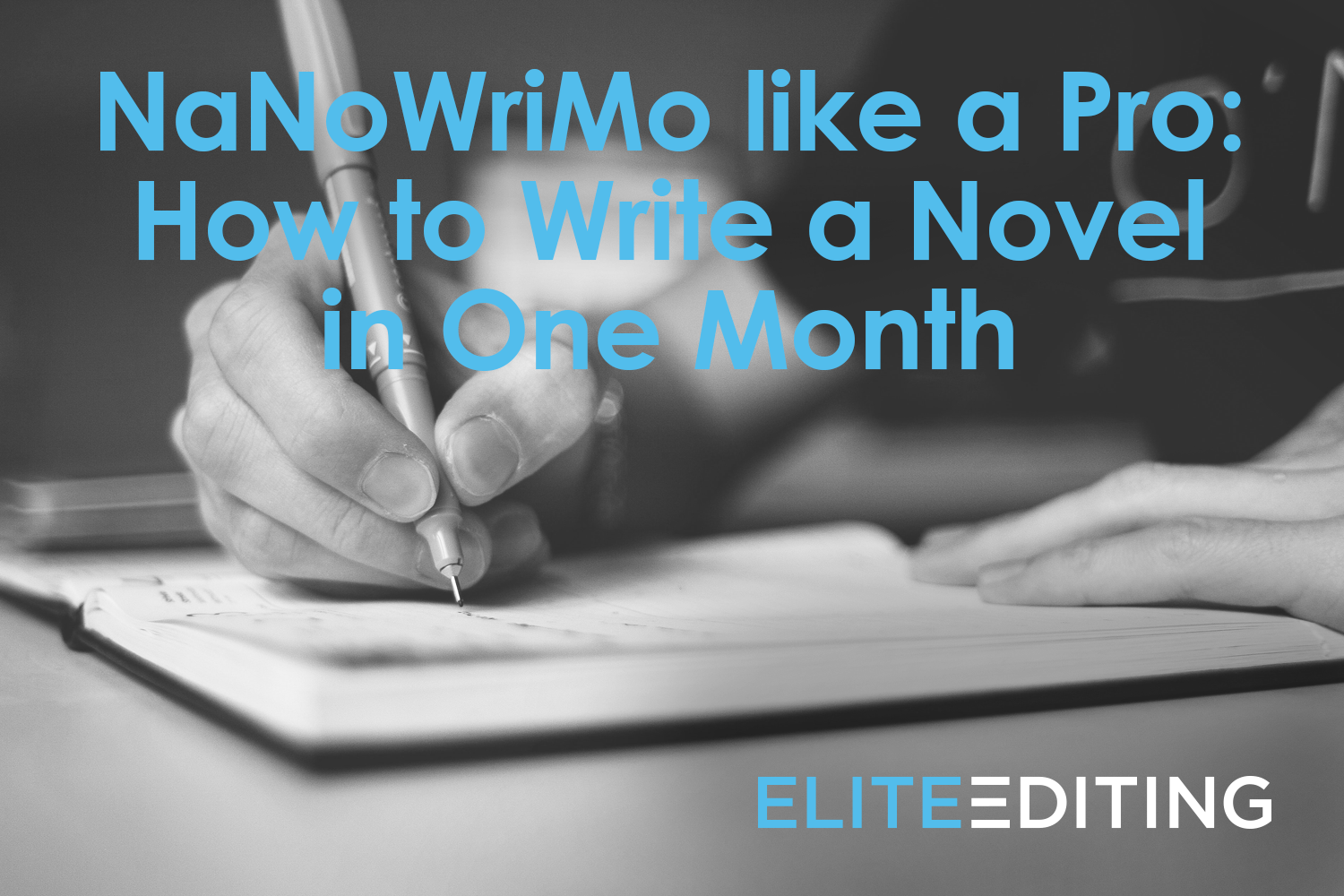November is National Novel Writing month, and it’s here! Have you ever dreamed of writing a novel but feel you don’t have time to get that best-selling story rattling around in your head onto the page? Elite Editing wants to help you write a book in a month with some tried-and-true advice for NaNoWriMo and beyond. Want to learn how to write a novel in one month? Read on, wrimo; read on!
A wrimo is someone participating in
National Novel Writing Month!
What Is National Novel Writing Month?
National Novel Writing Month (NaNoWriMo) is both an event and a nonprofit organization. The event, which begins on the first day of November every year, is a thirty-day writing spree with the goal of getting (at least) fifty thousand words on the page before the month is out. The nonprofit organization (also called NaNoWriMo) facilitates this event and offers a support system for participants during November—and year round!
Why Should I Join In?
There are dozens of reasons to jump on the NaNoWriMo bandwagon, and your personal motivations will vary. Of the dozens of reasons (some of which are outlined below), arguably the biggest is that it will show you how to write a novel in one month when you’re not sure you have time to be writing a novel at all. Anyone can write a book in a month, and NaNoWriMo proves it.
Solidarity
Even though it’s called “National” Novel Writing Month, it’s not limited to any one nation; every year wrimos from around the world join in the creativity and fun. Writing a novel is a very personal and subjective journey, and it is usually lonely work. But not during NaNoWriMo when everyone and their brother, mother, son, and neighbor are clacking away on keyboards or scribbling feverishly in fresh notebooks right (write?) along with you.
Online forums
The NaNoWriMo website is an excellent resource for aspiring wrimos to get support, advice, and inspiration. Fro word sprints (timed writing challenges) to writing buddies who hold each other accountable throughout the month to regional (local) forums to connect you to nearby wrimos, National Novel Writing Month has created a community atmosphere online that attracts new and veteran novelists every year. Any lingering questions you might have about how to write a novel in thirty days will be answered somewhere in the forums or the blog.
NaNoWriMo events
National Novel Writing Month also created the “Come Write In” program to encourage local businesses to allow wrimos to bring their weapon of choice and write their novels at that location. In addition to this, many of these businesses also host kick-off events, scheduled write-ins, and celebratory end-of-the-month parties. Local veteran wrimos known as municipal liaisons (MLs) are there as organizers and mentors to help you figure out how to write a novel in one month without losing your mind in the process.
Social media support
National Novel Writing Month is a huge event, and there are dozens of social media pages and groups dedicated to helping wrimos achieve noveling greatness in the month of November and beyond. Local regions often have their own social media groups, as well, to coordinate NaNoWriMo events in that particular area. Even photo-sharing platforms like Instagram get in the NaNo spirit with things like this Preptober prompt list.
Family affair
NaNoWriMo isn’t just for grown-ups. With their Young Writers program, you can get the kids in on the fun too. Making National Novel Writing Month a family activity can add to the fun, keep your spirits (and motivation) high, and jump-start your creativity. After all, if your kiddo can figure out how to write a novel in 30 days, surely you can too.
Accountability
When you’re researching how to write a novel in one month, one of the major themes you’ll come across is accountability. NaNoWriMo encourages aspiring novelists to announce their noveling intentions to the world, including putting a name (title) and a face (cover) to their upcoming creations. This way, there’s no easy way to back out if the going gets tough—you have to work through your blocks and get back in your groove. You committed, after all.
Perks and prizes
Beyond a sense of personal satisfication, there are goodies waiting for you if you “win” NaNoWriMo by completing fifty thousand words. The prizes are offered by sponsors, who keep the lights on at the National Novel Writing Month nonprofit, and they vary from year to year. Some of these sponsors also offer perks to NaNoWriMo participants through the month of November just for participating.
Fun
We’ve saved the most important reason for last. Wrimos don’t join in this creative spree to stress and worry and pull their hair out. It’s supposed to be fun. You win some stuff, you meet other writers who live near you, you make friends, and (if all goes to plan) you come out of November with a novel.
Before You Begin
Preptober (otherwise known as October) is the month before NaNoWriMo, a time when wrimos around the world begin tying up loose ends, freeing up time, and shoring up their caffeine and snack supplies to sustain them through the month of writing. Depending on your preferred writing style, your “how to write a novel in one month” warm-up routine will vary.
Know yourself
What do you enjoy most about writing? Planning things out or discovering things as you go? This is an important question when determining where you fall on the “plotters vs. pantsers” spectrum, which, in turn, determines what kind of preparation you need to do for NaNoWriMo.
Plotters
Do you like to understand your story and know your characters better than you know yourself? Then you’re probably a plotter. Plotters are the cartographers of NaNoWriMo. They have a map. They know where they’re going and how to get there, and they have a way back if they get lost. Some say that planning takes away the excitement of writing a story, but plotters disagree. It is a way for them to connect with their story on an almost parental level.
Pantsers
Would you rather just start writing and see where the story takes you? That means you’re probably a pantser (as in, “by the seat of your pants”). Pantsing is a fun and exciting approach to writing: just letting the words flow and following the current of creativity wherever it leads. This can lead to snags and writer’s block and rambling tangents, but pantsers are prepared for that. They exercise their creative muscles and think their way out of problems on the fly.
Plotters vs. pantsers
Both approaches are valid, and they work well for the people who choose them. J. K. Rowling—who famously first wrote Harry Potter and the Sorcerer’s Stone on a bar napkin—could be classed as a pantser. J. R. R. Tolkien, on the other hand, plotted his way to greatness by spending the better part of a decade building Middle Earth before he ever penned a story about a hobbit. See the chart below and find the statements that sound most like your approach to writing to figure out where you fall. If you’re right down the middle, you may be a plantser.
| QUESTION | PLOTTER | PANTSER |
| Do you have an outline? | I have an outline of every scene, with conflict and key dialogue noted. | Outline? I don’t need no stinkin’ outline. |
| Tell me about your main character. | My main character’s best friend from childhood died a year before my story starts, and it has really affected her outlook on life. | My main character? I think his name is Brad. |
| What is your story about? | My story is about a stock broker who loses everything in a market crash and suddenly finds himself struggling with poverty, depression, and drug addiction. In a last-ditch effort to regain his sanity, he flees the city and takes shelter at a country farm when his car breaks down and… | I’m pretty sure my story is about a renegade elf who betrays the king. But it might be about a dolphin. |
| How do you get past writer’s block? | I look at my outline to see what comes next. | I add a twist or a turn or a story element that gets my character out of the situation and back on track. |
| Do you know how the story ends? | Of course! It’s tragic but satisfying. | Of course not! Where’s the fun in that? |
| Are you going to win NaNoWriMo? | Yes! | Yes! |
What is a plantser?
Plantsers are Switzerland in the plotters vs. pantsers face-off. They are neutral, a middle ground, a compromise between the two extremes. Plantsers do a little planning before November, maybe scribbling a minimalist plot outline or mapping some key character traits or settings. From there, they jump into the story headfirst on November 1 and figure out how to write a novel in 30 days based on their ingenuity, with only the bare bones of their story to guide them if they get stuck.
If you’re a plotter…
Plotting makes it easier to learn how to write a novel in 30 days, but knowing how your story ends can take some of the excitement out of writing. Leaving some elements to chance can be intimidating, but it also gives you the opportunity to make some discoveries as you write.
Write an outline.
This is your story map. It is how you get from beginning to end without taking a wrong turn. It can be as detailed or as loose as you want, but as a plotter, you need an outline. Resist the urge to plan out every single minute detail, though. To keep the process fresh and fun, leave yourself some minor problems to solve while writing.
An outline usually contains notes about all of the scenes that make up the core of your story. It is an at-a-glance guide to your entire story from start to finish. Where does the scene take place? Who is in it? Whose point of view is it written from? What happens, and what, if anything, is said? What is the purpose of the scene? All of these details are important.
Get to know your characters.
You don’t need to fill out a hundred-question character interview to get to know your characters, but you can if you want to. What you really need to know is what their names are, what they look like, what their values are, and what their key personality traits are. At a minimum, do this for your main characters and your secondary characters. These are the characters that drive your plot, and it’s important to know how they would react to avoid out-of-character behaviors.
If you’re a pantser…
Learning how to write a novel in thirty days without a game plan can be tough when you hit a wall without a guide. However, it’s a sink-or-swim rush of excitement as you race the clock to get from point A to point B without a map by the end of November. Just remember to have some prompts and inspirational material handy in case you write yourself into a corner and need an escape hatch.
Get in your groove by doing daily freewrites.
This is extremely important to developing a writing habit as well as getting the creative juices flowing freely—and you’ll need them! Think of this as a daily workout for your brain; exercising your muscles makes them stronger and capable of doing heavier and heavier lifting, in the same way that exercising the mind makes it capable of writing your story without a fallback plan to guide you.
A freewrite is a writing exercise wherein you write for a certain amount of time on a given prompt, without structure or rules to govern what you’re writing. The prompt may be as vague as “stream of consciousness” (writing literally every thought that pops into your head as it does so) or as specific as “Sally is a fourteen-year-old black girl going for a walk in 1955 Birmingham, Alabama. Describe the experience.”
Try fun writing prompts.
Writing prompts are essential to freewriting exercises. Sure, you could use the same stream-of-consciousness prompt every day, but it would get boring…and fast. Fun prompts can frame the exercise in a new and exciting way. There are countless apps, websites, blogs, eBooks, hardcopy books, and articles to provide you with prompts galore.
If you’re a plantser…
Plantsing is the perfect marriage of plotting and pantsing—maintaining all the excitement of writing by the seat of your pants while having the security of a rough story map when you get stuck. Find the balance that works for you, and you’ll be well on your way to NaNoWriMo success.
Write a minimal outline of your key scenes.
You need a plan to be a plantser, and that means having a basic outline. This won’t be as in-depth as a plotter’s outline, but it should summarize the key scenes in your novel. You need to know the characters, the conflict, and the overall action in the scenes that steer your story, but you don’t necessarily have to know the scenes that come in between.
A key scene is a scene that defines one of the major plot points of your story structure. The most common story structure in fiction is the arc. You have an introduction, an inciting incident (or two), rising action, crises points, a climax, falling action, and your denouement (the resolution). Outline at least one scene for each of these so you know where you’re headed.
Blurb your story.
A story blurb is a quick synopsis of the plot that can help you keep track of where you are. Write two or three lines for each of the scenes in your outline and stitch them together into a ministory. This can serve as your synopsis for marketing purposes later, and it should be a living document. If you add another crisis point or change your inciting incident, update your blurb, so you can keep track.
One Month Starts…Now!
You don’t have to wait until November to start working on your novel. In fact, on the NaNoWriMo website, there’s a badge for those who rebel and start their work ahead of time! If you’re worrying about how to write a novel in 30 days, it’s okay to get a head start—or just to start early so you don’t lose your nerve. For the sake of argument, though, “today” is November 1, and NaNo starts…now!
Desired final word count divided by thirty = daily writing goal
One of the keys to learning how to write a novel in thirty days is to choose a manageable final word count to work towards. For new writers, fifty thousand is the baseline goal, and that is the NaNoWriMo official word count goal. This breaks down to 1667 words every day of the month, which is about two hours of writing (sometimes more, sometimes less). If you are feeling particularly ambitious, you could always increase your word count. Whatever your target is, divide it by thirty and you’ll have your daily writing goal.
Why fifty thousand words?
Fifty thousand words may seem like a daunting goal, especially when you’re trying to figure out how to write a novel in one month, but it’s the threshold that separates a novel from the shorter novella. It’s the low end of average breakout novel word counts—and it also happens to be Depending on your genre, your word-count goal could range from fifty thousand for a light romance or middle-grade novel to three times that many for epic fantasy or hard science fiction.
Stop every day in the middle of a sentence.
This may seem like random (and bad) advice, but it is one of the few agreed upon tenets of how to write a novel in one month. By stopping in the middle of a sentence every day, you give yourself an automatic jumpstart for the next day’s writing. This is an especially important step for pantsers as it can help stave off writer’s block.
Avoid revising—just keep writing.
While revising is a key aspect of writing a novel, it is the enemy of learning how to write a novel in one month. Fighting off your inner editor is critical to NaNoWriMo success. Why? Because if you stop every time you make a mistake, you will eat up all of your writing time, and you won’t make it to your goal. It doesn’t matter if you see a typo in the sentence that you just put on the page; ignore it. Don’t look back. It’s too late. Just. Keep. Writing.
Don’t delete anything.
This is very, very important. Even if you reread your work from yesterday and decide it’s terrible, do not delete it. Just move forward with today’s goal. By deleting work, you are increasing your overall word count and throwing off your schedule. Remember how you thought you didn’t have enough time to write a book in a month in the first place? You definitely won’t if you have to write it twice.
Don’t overthink.
First drafts are not meant to be perfect; their sole purpose is to get the story onto the page in its raw form. All first drafts are terrible. We promise. That’s what rewrites and editors are for. If you notice halfway through your story that something doesn’t work, just keep going. You can fix it later—when you aren’t writing feverishly. Don’t overthink the plot holes, the typos, the characters, or the weird way that one merchant talked in the secod chapter. Just get it on the page, and you can polish it until it shines in December.
Make Any Month Your Own Novel Writing Month
November may be National Novel Writing Month, but there’s no rule saying that it’s the only month to write novels. Even NaNoWriMo runs a summer version in June and July called Camp NaNoWriMo. Any month can be your novel-writing month.
Pick a start date.
Setting a date is important because it forces you to take action. Clearly define your thirty-day period. Mark it on your calendar. Announce it to the world. Do whatever you need to, but commit to it.
Hold yourself accountable.
And, of course, by “commit” we mean, “Don’t back out or make excuses or cut yourself slack for missing your goals because it’s not really NaNoWriMo.” Without the solidarity of the wrimo community to hold you to your goals, you’ll need to be your own motivator. You know how to write a novel in one month. So go do it.
Don’t look back.
Just like with NaNoWriMo, wrestle your inner editor to the ground during your personal novel writing month. Don’t worry about writing perfection; worry about writing, period. Don’t make excuses, and don’t second-guess yourself. Commit to the story, commit to your goals, and get it done.
What Next?
Picture this: It’s December 1. The dust has settled on your keyboard after your thirty-day spree of creativity and rapid-fire typing. You open your story document and see the magic number: fifty thousand words. And you’re thinking to yourself, “Well, what do I do now?”
Celebrate!
You did it! You won! Go claim all your goodies from the NaNoWriMo winner’s page, shout your achievement from the rooftops, and dance in the streets. You wrote a novel in a freaking month. Party on, wrimo; party on! Because tomorrow? Tomorrow, there’s more work to do.
Revise your first draft in thirty days however many days you need.
Don’t fall into the trap of sending out your thirty-day novel to agents, editors, or your friends. A thirty-day novel is a fabulous thing, but it’s only a first draft—and the really fun stuff starts now. Remember all those typos and plot holes and weird, stilted dialogue we told you to ignore in November? Now is when you fix it.
Now is when you iron out all of the wrinkles and fix all the errors. Go through your whole story with a fine-toothed comb. Examine each scene, and make sure it serves a purpose. Anything that is deadweight needs to go or to be rewritten into something valuable to the story. All first drafts are terrible, but revision shapes a draft into perfection.
Revise and…go?
Now it’s time to start the publishing process and get your novel out into the world. Beta reading (when your friends, family, and other writers you know read your work) is extremely beneficial for making sure that the story and the style work for the audience you’re trying to reach. We highly recommend it, but it’s not the only thing you’ll need to do.
Hire an editor.
Yes, really. Even after you did all that work revising your story, you still need a set of unbiased and experienced eyes to give it a read-through. Sure, it may be that you didn’t miss anything, but what if you did? Proofreading errors will get your manuscript tossed in the reject pile faster than you can type “you’re manuscript.”
Write a query letter.
Politeness and the ability to follow directions go a long way in the book industry. Most publishers and agents require you to write a query letter for your manuscript, and this is where a synopsis comes in handy. They want to know what the book is about before they spend time reading one that doesn’t fit their market. We can help you write the perfect query letter for your novel.
Consider independent publishing.
Traditional publishing is great. It often means better marketing, better design, and, ultimately, better paychecks. However, it also means a loss of creative control, a loss of certain rights for a period of time, and an almost ubiquitous need for an agent (which means more money out of your pocket). Independent publishing is growing in popularity among authors who want to cut out the middlemen and get their story into the world, especially with the ready availability of publishing mediums like Kindle Direct, which let you enjoy the perks of traditional publishing while maintaining control.
 Submit to agents.
Submit to agents.
If you choose to go the traditional route, you will almost certainly need an agent to act as an intermediary between you and your publishing house. However, good agents spend a lot of time on their authors, and they can help you further improve your book—and your writing more generally. You should submit query letters to several agents in your genre, and don’t take it personally if you get rejected by a few before you find one to take you on.
In conclusion
Maybe writing a novel in thirty days isn’t easy, but it is far from impossible. Every year, thousands of people from all around the world pull out their laptops and start turning their dreams into first drafts. If you’ve been waiting for the right time to write, or you’ve been putting it off because you don’t have the time, the only question left to ask yourself is not this one:
“How do I write a novel in thirty days?”
It’s this one:
“How much do I want to be a novelist?”
Need more NaNoWriMo help? Check out these other posts:
9 Awesome Online Writing Resources










